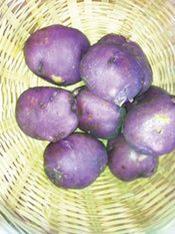
With its mainstay varieties, some would argue that the fresh produce aisle has become a little too overfamiliar lately. But what if there was a way to travel back to the past and bring back thousands of unique varieties without the need for Doc Brown? Many growers up and down the country are doing just that.
You could call Robert Hocking of Buttervilla Growers the Indiana Jones of heritage varieties. Hocking’s search for historic seeds has taken him on a global adventure to everywhere from Australia to Asia, and the fruits of his labour have led family business Buttervilla Growers to become one of the main suppliers to Jamie Oliver’s swish flagship Fifteen restaurant.
“I’m an old hippie as I’ve been growing heritage tomatoes for the best part of 40 years, but heritage varieties really do taste far superior to what is currently on the shelves,” argues Hocking. “Searching the world is crucial to find the best seeds and we produce a rare, black-coloured tomato called the Black Krim, which was originally from the Isle of Krim on the Black Sea in the former Soviet Union. Generally I find that the uglier or older the tomato is, the better it tends to taste.”
Thousands of British varieties disappeared in the 1970s, when the European courts ruled that all future seed must be registered on a national list. “With high EU registration rates, many growers only kept the faith in their most profitable varieties, effectively writing off thousands of historic seeds,” explains Neil Munro of Garden Organic.
Munro is in charge of the grower charity’s heritage seed library and supplies over 5,000 heritage seeds to its 9,000 members every year. “We get requests for tomato varieties from Lincolnshire or pea seeds cultivated in Cornwall; I think nowadays people want to know the growing history of the vegetables on their plate,” he adds.
Munro has some colourful varieties on his books, with pea seeds said to have been found in Egyptian pharaoh Tutankhamun’s tomb proving popular, and he believes there is a definite gap in the market for heritage produce. “There is a real opportunity for a lot of these century-old seeds to be commercially sold; a bit of history to go with vegetables has all sorts of marketing possibilities.”
Currently, the European SAVE Foundation is calling on the EU to roll out a ‘heritage’ brand on all labels of heritage vegetables that hold historic significance, but one producer is already ahead of the game. Irish-based Glens of Antrim Potatoes has cast aside 170 years of history by resurrecting a famous potato which has not been commercially cultivated in Ireland since the potato famine of the 1840s.
The Irish Lumper, a distinctive ‘knobbly’ shaped fluffy potato, is now being sold in supermarkets with its packaging telling the story of its rich history. “I guess you could call this a passion project as this took us six years to commercialise,” admits Michael McKillop, MD of Glens of Antrim Potatoes, which also produces five other heritage varieties including the Irish purple Arran Victory potato which was bred to celebrate the end of the First World War in 1918. “We wanted to give people the chance to taste something their ancestors would have eaten regularly; we’ve launched the Lumper as a limited edition so we can test out the market before we expand it any further.”
But while heritage varieties may sound good in theory, the unpredictable growing conditions of old seeds can make commercialisation and hydroponics difficult to implement. “You have to bring those varieties back and then test them in accordance to today’s climate; only when you put them in the ground do you know their full potential and the Irish Lumper has been a difficult process at times,” explains McKillop.
However, Buttervilla Growers’ Hocking enjoys the growing process and feels the fact most heritage seeds are open pollinated leads to more biodiversity. “The older varieties are often open pollinated rather than hybrids so you have variation in growth; you wont get a uniform crop that matures at the same pace and that makes every plant unique.”
Hocking’s next plan is to produce a range of vintage strawberries. “I always remember the best strawberries I ever ate were on a family holiday in France around 20 years ago so I went back to France on the hunt for that seed. I found what I was looking for and we now produce the French Gariguette variety, a strawberry that goes back hundreds of years, and, for me, its taste far outweighs any of the commercial varieties currently available.”
Heritage varieties are all around us and Monro believes implementing more of the past could create a more vibrant future for the fresh produce industry. “People don’t realise that supermarket favourites like the Little Gem lettuce were first bred in 1867 and are actually heritage; these types of varieties were passed down generation by generation and I hope the industry can make steps to continue that legacy.” -






No comments yet